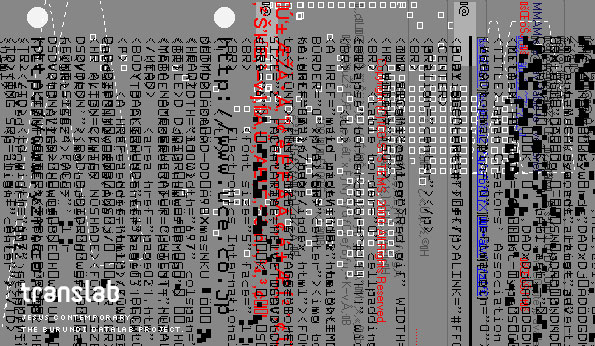
|

|

[art] 1998 Jodi software OSS/*** opposes “normal” desktop – if you don’t press the mouse, you draw a line, if you click, you hear a sound instead of activating an icon, and it includes drop down menus without thext, while windows full of text gibberish. Jodi: „we get a lot of ideas from making errors ourselves at our own computer – when the system locks, gets frozen, shakes and flips while crashing. That is OSS, pure blue panic.. we want to share these rare moments with everyone.“   |
|

|

|

|

|

[phil] 1979 Jean-Francois Lyotard in Postmodern Condition essay states, that modernity maintained order, stability and totality through grand narratives (master narratives, metanarratives), stories a culture tells itself about its practices and beliefs, ideology that explains an ideology, the story that is told to explain the belief systems that exist (ie US culture: democracy is the most enlightened form of government and will lead to universal human happiness; marxism: capitalism will collapse in on itself and a socialist world will evolve). He goes on saying, that every attempt to cerate „order“ always demands creation of equal amount of „disorder“, but grand narrative masks the constructedness of these categories by explaining that „disorder“ REALLY IS chaotic and bad, and that „order“ REALLY IS rational and good. Postmodernity, in rejecting grand narratives, favors mini-narratives, stories that explain small practices, local events, rather than large-scale universal or global concepts; are always situational, provisional, contingent, temporary, making no claim to universality, truth, reason or stability.  |
|

|

|

|

|
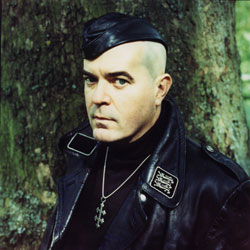
[snd] 1975 American archivist and writer Boyd Rice begins experimenting with the possibilities of pure sound. In his live performances, he attaches an electric fan to an electric guitar and also uses an electric shoe polisher as an instrument. He creates extremely loud, cascading walls of noise and plays pieces of recorded conversations, news reports, and music just beneath the threshold of comprehensibility. Combining brutal soundscapes with various poetics. He also structures noise elements into harmonious, rhythmic pieces that defy easy categorization.   |
|

|

|

|

|

[art] 1974 Steina and Woody Vasulkas create Noisefields. The work presents the image of a circle keyed on a background of electronic snow. The circle rapidly disappears and reappears, displaying every chromatic variation possible (from blue to orange). This high-speed flickering is accompanied by a recurring beat that keeps time with the changing real-time image.   |
|

|

|

|

|

[art] 1965 In Magnet TV, Nam June Paik first works with only a horseshoe-shaped electromagnet and a degausser, used by technicians to deactivate the television screen’s state of being charged. The magnet’s force of attraction hinders the cathode rays from filling the screen’s rectangular surface. This pushes the field of horizontal lines upward thus creating baffling forms within the magnet’s gravitational field. If the magnet maintains its position, the picture remains stable—apart from minimal changes caused by fluctuations in the flow of electricity. Moving the magnet causes endless variations on the forms.  |
|

|

|

|

|

[snd] 1951 In the John Cage's Imaginary Landscape No.4 composition for 12 radios, 24 performers, and director, two performers each operate radios whose kilocycle, amplitude, and timbre changes are notated. The score is conceived using the same methods as those used for the composition The Music of Changes.   |
|

|

|

|

|

[snd] 1924 George Antheil's Ballet Mécanique is scored for player pianos, percussion, and airplane propellors. A scandalous success at its first performance in 1926, it is known for its outrageous orchestration and the idea of using non-traditional sounds in a musical context.  |
|

|

|

|

|

[snd] 1913 Luigi Russolo, avowed Futurist, writes L'Arte dei Rumori (The Art of Noises), a manifesto declaring that noise would revolutionize the concert hall. He says, "All this will naturally make music-lovers scream ..." He then builts the Intonarumori (noise-generating instruments). On April 24, 1914, at the Teatro Dal Verme in Milan, he conducts the first 'Gran Concerto Futuristica' with formally dressed musicians playing gurglers, cracklers, howlers, thunderers.. The audience responds by throwing vegetables, booing, hooting and whistling.  |
|

|

|
|
|

|

|
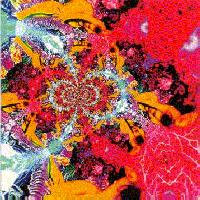
[snd] 2000 Australian label Extreme releases Merzbow's 50cd Merzbox accompanied by a book. The collection spans from 1979 to 1997 of Masami Akita's sonic decompositions.  |
|

|

|

|

|

[snd] 1985 Christian Marclay's records Record Without A Cover has only one playable side, the other has titles and text pressed into it and comes unwrapped with the instruction: "Do not store in a protective package".  |
|

|

|

|

|

[snd] 1979 The enduring version of David Tudor's Rainforest is an installation in which audience members walk through a 'rainforest' of suspended found objects, each of them generating a particular sound. The objects resonate with sounds applied to them through contact loudspeakers, and those resulting resonances are then fed via contact microphones to loudspeakers around the hall. In Tudor's words, "The microphones are releasing the sound of the objects -- you put the sound through a physical material ... [and] you release the harmonic content which the material gives to it."  |
|

|

|

|

|
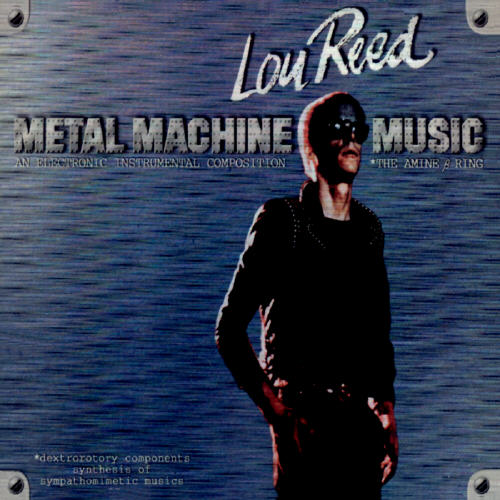
[snd] 1975 Lou Reed records Metal Machine Music consisting the four tracks each lasted 16:01 minutes. The album consists primarily of guitar feedback. It is generally considered to be either a joke, a begrudging fulfillment of a contractual obligation, or an early example of experimental noise rock.   |
|

|

|

|

|
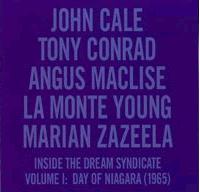
[snd] 1965 John Cale, Tony Conrad, Angus Maclise, La Monte Young and Marian Zazeela record in NYC loft a single 31 minute piece
Inside the Dream Syndicate Volume 1: Day Of Niagra, a "dream music" of precise pitched drones for extreme duration.  |
|

|

|

|

|
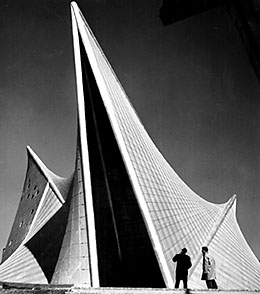
[snd] 1958 The program in the Philips Pavilion during the Brussels World's Fair consists of Edgard Varèse' Poème Electronique played through 400 loudspeakers, projected images and colored lights created by Le Corbusier, and Iannis Xenakis' Concrète PH played as an interlude between shows. Xenakis' composition uses the sounds of burning charcoal as its source material, transformed through various tape machine manipulations and was composed at the studios of the Groupe de Recherches Musicales in Paris.  |
|

|

|

|

|

[snd] 1948 Pierre Schaeffer composes Etude aux Chemins de Fer (Railroad Study), a recorded assemblage of steam engines, whistles, and other railroad sounds. It is the first recorded assemblage of sounds. He coins the term musique concrète to describe a music made 'concretely' by working directly with sounds, as against music made 'abstractly' by working with symbols for sounds (as in a musical score). In 1951, he organizes the Groupe de Recherche de Musique Concrète, the focus of which was working with tape recorders.  |
|

|

|

|

|

[snd] 1922 Arseny Avraamov's Hooter Symphony (Symfonia gudkov) is one of the musical events of city-wide environmental performances, using actual noise sources such as factory sirens, steam whistles, ships' foghorns and artillery, that were organised by Russian Futurists between 1918 and 1924.  |
|

|

|

|

|

[film] 1896 George Melies is filming a late autumn afternoon Paris crowd caught in the ebb and flow of the city's traffic. He is in the process of filming an omnibus as it is coming out of a tunnel, and his camera jams. He tries for several moments to get it going again, but with no luck. After a couple of minutes he gets it working again, and the camera's lens catches a hearse going by. It is an accident that is unnoticed until he gets home. When the film is developed and projected it seems as if the bus morphed into a funeral hearse and back to its original form again. In the space of a random error, Melies creates what we know of today as the cut.  |
|

|

|
|

